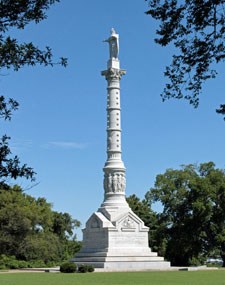
NPS Photo
On October 24, 1781, Lt. Col. Tench Tilghman, Washington's aide-de-camp, reached Philadelphia and the Continental Congress with the "glorious" news of the surrender of Cornwallis' army at Yorktown, on October 19th. On Monday, October 29, Congress officially recognized this great victory and by resolution directed:
That the United States in Congress assembled, will cause to be erected at york, in Virginia, a marble column, adorned with emblems of the alliance between the United States and his Most Christian Majesty; and inscribed with a succinct narrative of the surrender of earl Cornwallis to his excellency General Washington, Commander in Chief of the combined forces of America and France; to his excellency the Count de Rochambeau, commanding the auxilliary troops of his most Christian Majesty in America, and his excellency the Count de Grasse, commanding in chief the naval army of France in the Chesapeake. 
NPS Photo However, no action towards actually building this monument was taken for a century though the congressional resolution was not forgotten. In 1834 the citizens of Yorktown had asked Congress that the monument be erected as specified in 1781 since, as the Congressional committee report indicated, it would emphasize "an event that terminated the struggle of our fathers for liberty and independence" and that "no event in our history is more worthy of commemoration than that which crowned the American revolution with success and triumph." The resulting bill anticipated the purchase of grounds and "a railing" around them. There was no follow up in 1834, however, nor in 1836 when the proposal was again active. When in 1876 a memorial from the Common Council of Fredericksburg, Virginia, was before Congress, the desirability of the project was recognized. The Committee of Public Buildings and Grounds nonetheless, felt that it needed to be postponed "...considering the financial condition of the country, and the fact that Congress, at the present session, has assumed the completion of the Washington National Monument..." A memorial from the City of Boston in 1876 suffered the same indecisive fate. The Centennial of Yorktown, however, was approaching and this became instrumental in generating the necessary interest. The matter of implementing the basic authority was raised in 1875 by Historian George Bancroft, in a letter to the Mayor of Newport, Rhode Island, in June of that year, pointed out that in 1781 "Congress [had] pledged to the victorious army, to France, to America, to the world, that the nation should build at Yorktown a monument of marble, with the emblems of the great alliance, to keep fresh in memory the all decisive successes that had been achieved." The letter and various memorial, although ineffective immediately, were part of the initial move that led to the erection of the monument. A study group was authorized by Congress in 1879 and positive action came a year later as the citizens of Chicago, the legislature of North Carolina and others added their voices to the increasing public swell. |
Last updated: October 18, 2022
